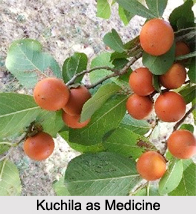 Kuchila, botanically known as Strychnos nux vomica is also known as Vishtinduka, Vishamushti and Poison-nut due to its poisonous properties. It has many health benefits but should only be used after purification. It is used in Ayurvedic treatments since the time of Sushruta.
Kuchila, botanically known as Strychnos nux vomica is also known as Vishtinduka, Vishamushti and Poison-nut due to its poisonous properties. It has many health benefits but should only be used after purification. It is used in Ayurvedic treatments since the time of Sushruta.
Nux Vomica has been introduced into Hindu medicine at a recent period. The Strychnos nux vomica is indigenous to most parts of India. The ripe fruits of the size of apples have a beautiful orange colour and contain a bitter gelatinous pulp, within which the flat and curiously umbilicated seeds are found imbedded.
Health Benefits of Kuchila
Nux vomica seeds produce a sort of intoxication, for which they are habitually taken by some natives as an aphrodisiac. Medicinally the seeds are used in dyspepsia and diseases of the nervous system. The detoxified seeds of Kuchila are used in treatment of neuralgia, facial palsy, hemiplegia, arthritis, gout, muscle pain, nerve pain etc. in low recommended dosage only. The seeds are nervine tonic and digestive. Nux-vomica gives relief in excessive vata and pain. It strengthens and stimulates nerves. It is a good appetizer, digestive and cures indigestion.
Dose of Kuchila in Medicine
Sarangadhara gives the following prescription in which the term vishamushti is usually understood to mean nux vomica. Take mercury, sulphur, aconite, ajwain, the 3 myrobalans, sarjikakshara (impure carbonate of soda), yavakshara, rock salt, plumbago root, cumin seeds, sonchal salt, sea salt, baberang, black pepper, long pepper and ginger equal parts, vishamushti (nux vomica seeds) equal in weight to all the above ingredients and make into pills of the size of black pepper corns with lemon juice. These pills are given to promote the appetite and increase the digestive power.
Samiragaja Kesari: Take nux vomica, opium and black pepper equal parts, and make into 2 grain pills. These are given with the juice of betel leaves in diseases of the nervous system.
Sulharanayoga: Take chebulic myrobalan, long pepper, black pepper, ginger, nux vomica, asafoetida, sulphur and rock salt in equal parts and make into 4 grain pills. These are given with warm water in dyspepsia with pain after meals, and in diarrhoea.
Related Articles
Ayurveda
Origin of Ayurveda
Ayurveda Medication
Elements of Ayurveda
Concepts of Ayurveda
Ancient Literature of Ayurveda
Sushruta Samhita




















